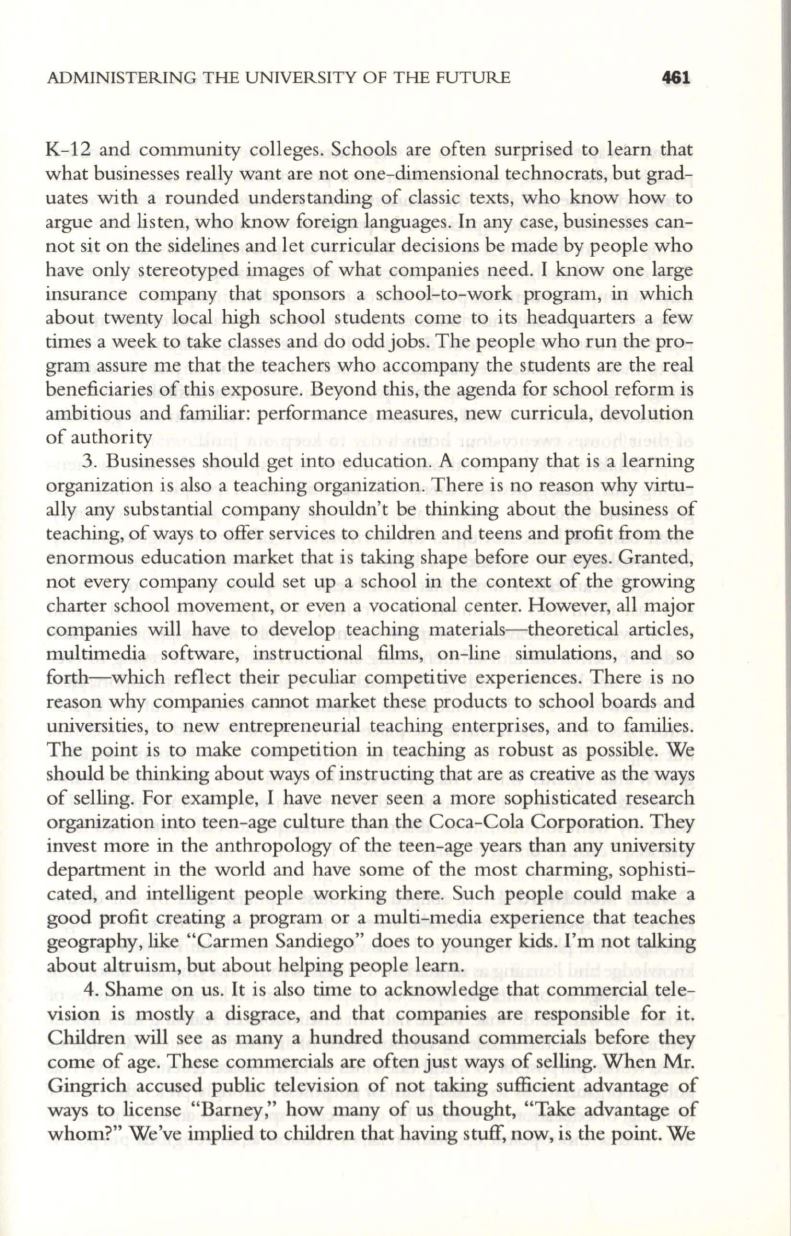
ADMINISTERING THE UNIVERSITY OF THE FUTURE
461
K-12 and community colleges. Schools are often surprised to learn that
what businesses really want are not one-dimensional technocrats, but grad–
uates with a rounded understanding of classic texts, who know how to
argue and listen, who know foreign languages. In any case, businesses can–
not sit on the sidelines and let curricular decisions be made by people who
have only stereotyped images of what companies need. I know one large
insurance company that sponsors a school-to-work program, in which
about twenty local high school students come to its headquarters a few
times a week to take classes and do odd jobs. The people who run the pro–
gram assure me that the teachers who accompany the students are the real
beneficiaries of this exposure. Beyond this, the agenda for school reform is
ambitious and familiar: performance measures, new curricula, devolution
of authority
3. Businesses should get into education. A company that is a learning
organization is also a teaching organization. There is no reason why virtu–
ally any substantial company shouldn't be thinking about the business of
teaching, of ways to offer services to children and teens and profit from the
enormous education market that is taking shape before our eyes. Granted,
not every company could set up a school in the context of the growing
charter school movement, or even a vocational center. However, all major
companies will have to develop teaching materials-theoretical articles,
multimedia software, instructional films, on-line simulations, and so
forth-which reflect their peculiar competitive experiences. There is no
reason why companies cannot market these products to school boards and
universities, to new entrepreneurial teaching enterprises, and to families.
The point is to make competition in teaching as robust as possible. We
should be thinking about ways of instructing that are as creative as the ways
of selling. For example, I have never seen a more sophisticated research
organization into teen-age culture than the Coca-Cola Corporation. They
invest more in the anthropology of the teen-age years than any university
department in the world and have some of the most charming, sophisti–
cated, and intelligent people working there. Such people could make a
good profit creating a program or a multi-media experience that teaches
geography, like "Carmen Sandiego" does to younger kids. I'm not talking
about altruism, but about helping people learn.
4. Shame on us. It is also time to acknowledge that commercial tele–
vision is mostly a disgrace, and that companies are responsible for it.
Children will see as many a hundred thousand commercials before they
come of age. These commercials are often just ways of selling. When Mr.
Gingrich accused public television of not taking sufficient advantage of
ways to license "Barney," how many of us thought, "Take advantage of
whom?" We've implied to children that having stuff, now, is the point. We


